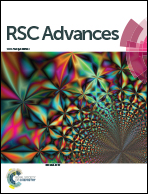Effect of the position of the urea group in the hydrocarbon tail of fatty acid amphiphiles on the physical gelation of organic liquids
Abstract
To investigate the effect of the position of the urea group in the hydrocarbon tail of an amphiphilic gelator, three positional isomers of 3-N-(n-tetradecylcarbamoyl)aminopropanoic acid (C14NHCO-APA) were designed and synthesized. The gelation behavior of these three amphiphiles in different organic solvents was investigated and compared. The amphiphiles were found to gelate organic solvents employed, but only in presence of H2O. The gelation in all the solvents employed was observed to be thermoreversible, having gel-to-sol transition temperatures (Tgs) above the physiological temperature (37 °C). It was observed that the critical gelation concentration (CGC) of the amphiphiles decreased; that is, gelation ability increased with the increase of spacer length between the –COOH and –NHCONH groups. The results suggested that H-bonding and van der Waals interactions have a major contribution in the gelation process. The morphology of the organogels was studied by XRD spectroscopy and electron microscopy. The amphiphiles were observed to form ribbon-like aggregates of high aspect ratio in organic solvents. The mechanical strength of the gels was studied by rheology. Their gelation abilities, Tgs values and values of yield stress (σy) of the organogels follow a similar trend, indicating that the gel becomes stronger when the urea linkage is in the middle of the hydrocarbon tail of the amphiphile.


 Please wait while we load your content...
Please wait while we load your content...